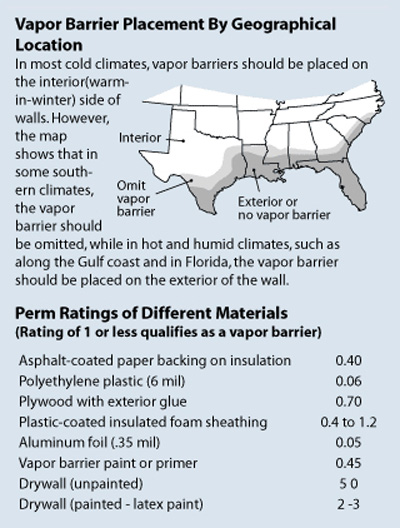Moisture Control
Moisture Control
Properly controlling moisture in your home will improve the effectiveness of your air sealing and insulation efforts, and vice versa. Thus, moisture control contributes to a home’s overall energy efficiency.
The best strategy for controlling moisture in your home depends on your climate and how your home is constructed. Before deciding on a moisture control strategy for your home, you may first want to understand:

How Moisture Moves through a Home:
To help understand the principles of moisture control, you need to understand the basics of how moisture can move through your home. Moisture or water vapor moves in and out of a home in three ways:
- With air currents
- By diffusion through materials
- By heat transfer
Of these three, air movement accounts for more than 98% of all water vapor movement in building cavities. Air naturally moves from a high-pressure area to a lower one by the easiest path possible-generally through any available hole or crack in the building envelope. Moisture transfer by air currents is very fast (in the range of several hundred cubic feet of air per minute). Thus, you need to carefully and permanently air seal any unintended paths to control air movement.
The other two driving forces-diffusion through materials and heat transfer-are much slower processes. Most common building materials slow moisture diffusion to a large degree, although they never stop it completely. Insulation also helps reduce heat transfer or flow.
The laws of physics govern how moist air reacts within various temperature conditions. The study of moist air properties is technically referred to as “psychrometrics.” A psychrometric chart is used by professionals to determine at what temperature and moisture concentration water vapor begins to condense. This is called the “dew point.” By understanding how to find the dew point, you will better understand how to avoid moisture problems in your house.
Relative humidity (RH) refers to the amount of moisture contained in a quantity of air compared to the maximum amount of moisture the air could hold at the same temperature. As air warms, its ability to hold water vapor increases; this capacity decreases as air cools. For example, according to the psychometric chart, air at 68°F (20°C) with 0.216 ounces of water (H2O) per pound of air (14.8g H2O/kg air) has a 100% RH. The same air at 59°F (15°C) reaches 100% RH with only 0.156 ounces of water per pound of air (10.7g H2O/kg air).
The colder air holds about 28% of the moisture that the warmer air does. The moisture that the air can no longer hold condenses on the first cold surface it encounters (the dew point.) If this surface is within an exterior wall cavity, wet insulation and framing will be the result.
In addition to air movement, you also can control temperature and moisture content. Since insulation reduces heat transfer or flow, it also moderates the effect of temperature across the building envelope cavity. In most U.S. climates, properly installed vapor diffusion retarders can be used to reduce the amount of moisture transfer. Except in deliberately ventilated spaces, such as attics, insulation, and vapor diffusion retarders work together to reduce the opportunity for condensation in a house’s ceilings, walls, and floors.
To effectively control moisture in your home, you need to first consider your climate when exploring your moisture control options. Moisture control strategies typically include the following areas of a home:
- Attics
- Foundation (includes: Basement, Crawl space, Slab-on-grade floors)
- Walls
In most U.S. climates, you can use vapor diffusion retarders in these areas of your home to control moisture. Proper ventilation should also be part of a moisture control strategy.
Vapor Barriers or Vapor Diffusion Retarders
In most U.S. climates, vapor barriers or vapor diffusion retarders should be considered as part of a moisture control strategy for a home.
How They Work
A vapor barrier or vapor diffusion retarder (VDR) is a material that reduces the rate at which water vapor can move through a material. The older term “vapor barrier” is still used even though it may inaccurately imply that the material stops all of the moisture transfer. Since everything allows some water vapor to diffuse through it to some degree, the term “vapor diffusion retarder” is more accurate.
The ability of a material to retard the diffusion of water vapor is measured by units known as “perms” or permeability. A perm at 73.4°F (23°C) is a measure of the number of grains of water vapor passing through a square foot of material per hour at a differential vapor pressure equal to one inch of mercury (1″ W.C.) Any material with a perm rating of less than 1.0 is considered a vapor retarder.
Vapor diffusion retarders can help control moisture in these areas:
- Basements
- Ceilings
- Crawl spaces
- Floors
- Slab-on-grade foundations
- Walls
Effective moisture control in these areas and throughout a home includes air sealing gaps in the structure, not just the use of a vapor diffusion retarder.
How, where, and whether a vapor diffusion retarder should be used depends on the climate. Typically, the number of Heating Degree Days in an area is used to help make these determinations. A Heating Degree Day is a unit that measures how often outdoor daily dry-bulb temperatures fall below an assumed base, normally 65°F (18°C).

Types of Vapor Diffusion Retarders
Vapor diffusion retarders are typically available as membranes or coatings. Membranes are generally thin, flexible materials, but also include thicker sheet materials sometimes called “structural” vapor diffusion retarders. Materials such as rigid foam insulation, reinforced plastics, aluminum, and stainless steel are relatively resistant to water vapor diffusion. These types of vapor diffusion retarders are usually mechanically fastened and sealed at the joints.
Thinner membrane types come in rolls or as integral parts of building materials. A common example of this is aluminum- or paper-faced fiberglass roll insulation. Foil-backed wallboard is another type commonly used. Polyethylene, a plastic sheet material, can be used as a vapor diffusion retarder for above-grade walls and ceilings (only) in very cold climates (in locations with 8,000 Heating Degree Days or higher).
Most paint-like coatings also retard vapor diffusion. While it was once believed that only coatings with low perm ratings constituted the only effective vapor diffusion retarders, it is now believed that any paint or coating is effective at restricting most water vapor diffusion in milder climates.
Installing Vapor Diffusion Retarders for New Construction
In climates with less than 4,000 Heating Degree Days, materials like painted gypsum wallboard and plaster wall coatings impede moisture diffusion to acceptable levels. Usually, no further vapor diffusion retarder is needed.
In more extreme climates, vapor diffusion retarders are advisable for new construction. They perform best when installed closest to the warm side of a structural assembly; in cold climates, this is towards the interior of the building. In hot/wet climates, this is towards the exterior of the building.
Reasonable rules-of-thumb to follow when placing vapor retarders include the following:
- In climates with 2,200 or more Heating Degree Days, locate the vapor diffusion retarder on the warm side of the exterior structural assembly. If possible, locate it on the inside of the assembly using the “one-third, two-thirds rule”: the vapor diffusion retarder has one-third of the cavity insulation to its warm side, two-thirds to the cold side. This protects the retarder from physical damage through errant construction or remodeling activities.
- In climates with fewer than 2,200 Heating Degree Days (cooling-dominated climates) and where the building is near, but not quite in, the 2,200 Heating Degree Days zone (a.k.a. fringe zone), place the vapor diffusion retarder in the same location as climates farther north.
- Farther south (about 1,900 Heating Degree Days) it is unimportant where the vapor diffusion retarder goes. For climates even farther south and generally hotter and more humid, some professionals recommend omitting the vapor diffusion retarder completely. This is due to the winter heating loads and summer cooling loads being roughly equal. Any location ends up having the vapor diffusion retarder on the wrong side of the structure during part of the year. However, other building science research indicates that it should be applied directly under the exterior finish and is sometimes itself the exterior finish. A combination air barrier/vapor diffusion retarder may be a better choice for this situation.
Knowledgeable builders typically use vapor diffusion retarders with ratings of 0.1 or less. However, if you carefully seal the warm-side vapor diffusion retarder and interior finish, you can also safely install a low-permeable material, such as rigid foam board insulation (a perm rating as high as 1.4), on the cold side of walls. A good rule-of-thumb: to prevent trapping any moisture in a cavity, the cold-side material’s perm rating should be at least five times greater than the value of the warm-side. Use a vapor diffusion retarder with a perm value of less than 0.50 if you also have a high water table.
When installing a vapor diffusion retarder, it should be continuous and as close to perfect as possible. This is especially important in very cold climates and in hot and humid climates. Be sure to completely seal any tears, openings, or punctures that may occur during construction. Cover all appropriate surfaces; otherwise, you risk moist air condensing within the cavity, which would lead to dampened insulation. The thermal resistance of wet insulation is dramatically decreased, and prolonged wet conditions will induce mold and wood rot.
Installing Vapor Diffusion Retarders in Existing Homes
Except for extensive remodeling projects, it’s difficult to add materials like sheet plastic as a vapor diffusion retarder to an existing home. However, many existing homes don’t really need a more effective vapor diffusion retarder than the numerous layers of paint usually on their walls and ceilings. These multiple layers are quite effective as a vapor diffusion retarder in all but the most extreme northern climates.
“Vapor barrier” paints are also an effective option for colder climates. If the perm rating of the paint is not indicated on the label, find the paint formula. The paint formula usually indicates the percent of pigment. To be a good vapor diffusion retarder, it should consist of a relatively high percent of solids and thickness in application. Glossy paints are generally more effective vapor diffusion retarders than flat paints, and acrylic paints are generally better than latex paints. When in doubt, apply more coats of paint. It’s best to use paint labeled as a vapor diffusion retarder and follow the directions for applying it.
